Above: ADM console constructed for NYC’s A+R Recording c. 1976
Nice set for y’all today, courtesy of reader T.F. T. sent over a large collection of ADM console images spanning the mid seventies into the 1980s. I know next to nothing about ADM, other than it was very well-made equipment: discrete op-amps, UTC or similar-quality transformers, and inductor-based EQs are featured in many of their modules. There’s not a tremendous amount of information on this kit online, but this guy always seems to have a few pieces of sale on eBay: both raw modules and P+P ready racked units.
Regarding the console pictured above, T. writes:
“it’s got the patented CRT spectrum graph option (left top) and it’s a Quad console, note the two panning joysticks on the upper right of the board. A&R made quad records for Project 3 with Enoch Light and some rock quad mixes were done there too. I have one of the ADM joystick panners, it was an interesting piece of machine work. 4 pots controlled by the joystick mechanism, driving VCA’s. All ADM consoles from the mid-70’s forward used their patented Slidex faders controlling VCA’s, nothing was done directly from the fader. In those days, you wanted to protect your console surface from spilled drinks and other substances. For what it’s worth, all the ADM stuff I have is on par with API, Harrison and Spectra of the same era. American design, different from Neve and the Brits.”
In the comments section at the end of the post (click ‘comments’), you can find some additional commentary from T.F. on the ADM brand and their products.
Scroll down for the rest of the photo set. If anyone is currently using any of these modules for audio production work, drop a line and let us know yr thoughts. And if you were involved with the ADM corporation, we’d love to hear a bit about the company; its origins, evolution, and current work of it’s principles/designers.
CIRCA 1976
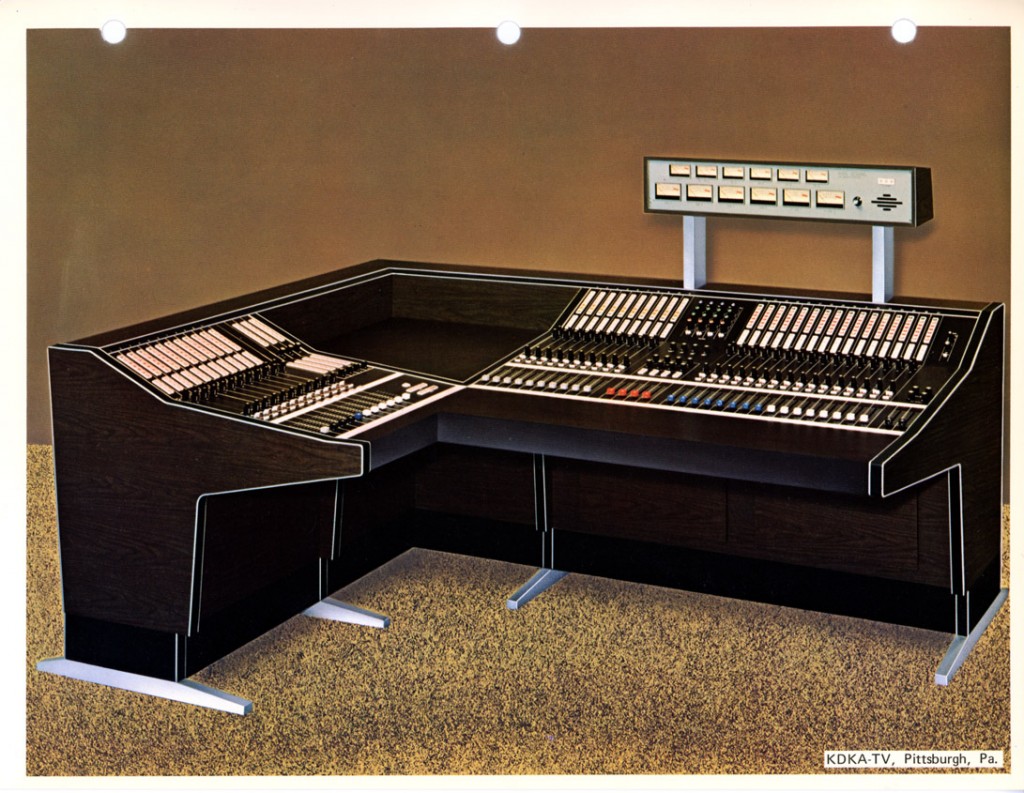 ADM console constructed for KDKA-TV, Pittsburg
ADM console constructed for KDKA-TV, Pittsburg
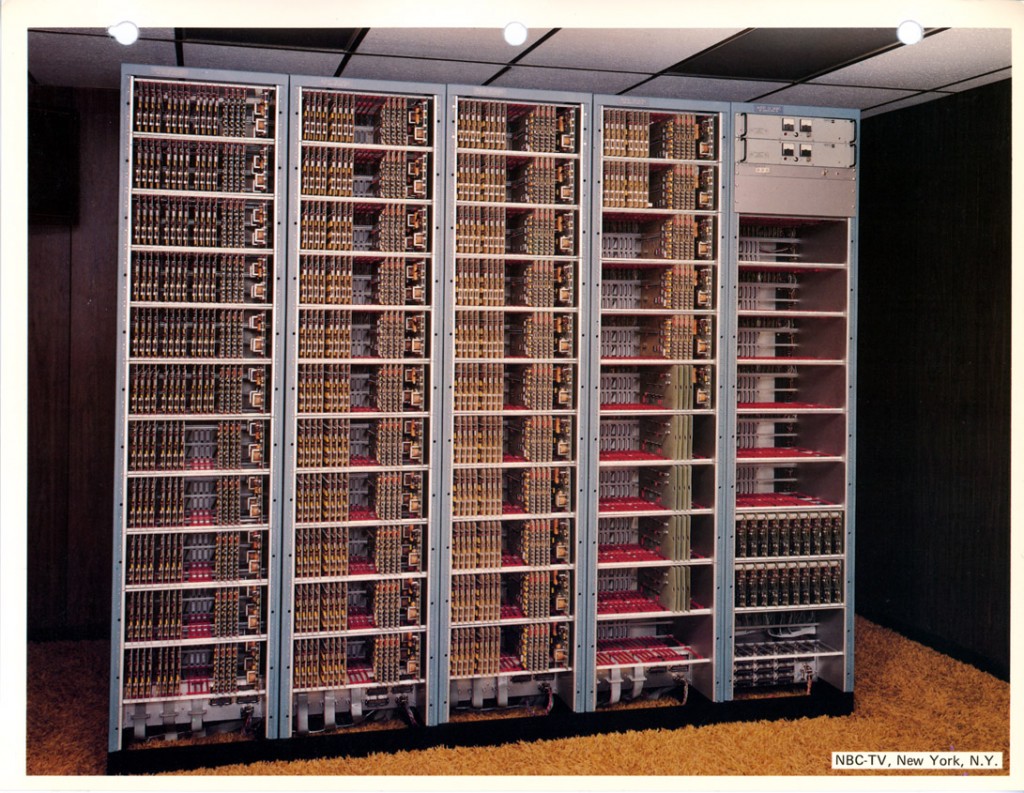 Routing system constructed for NBC TV, NY
Routing system constructed for NBC TV, NY
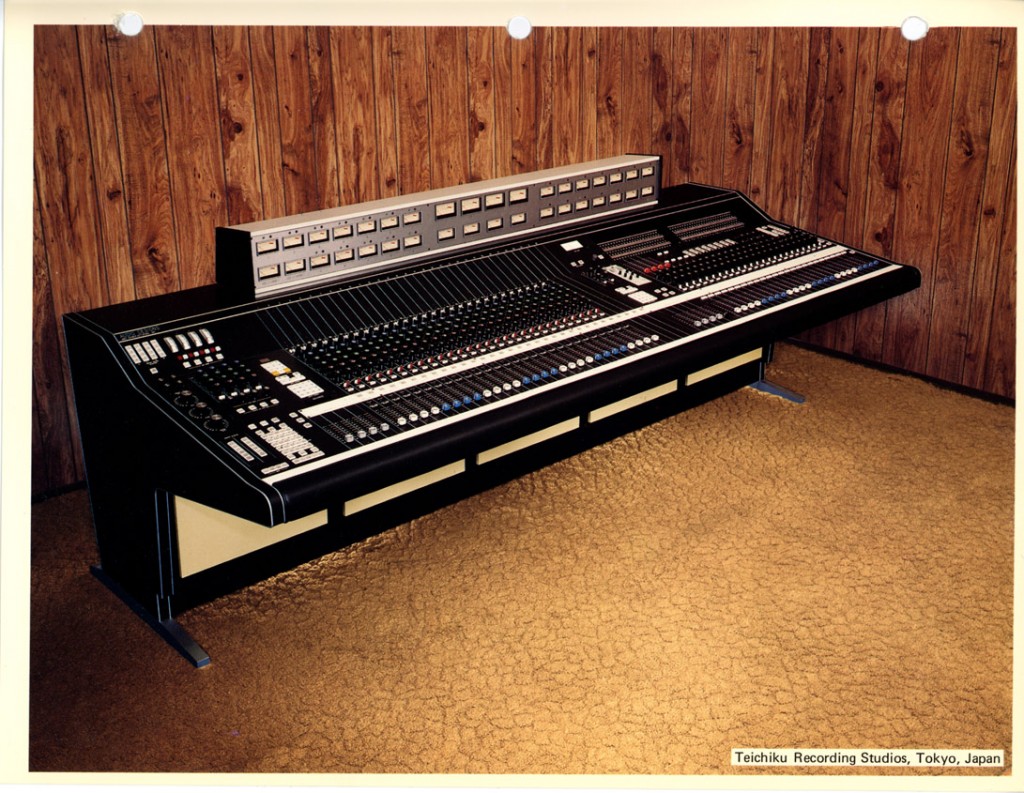 ADM console constructed for Teichiku Recording, Tokyo
ADM console constructed for Teichiku Recording, Tokyo
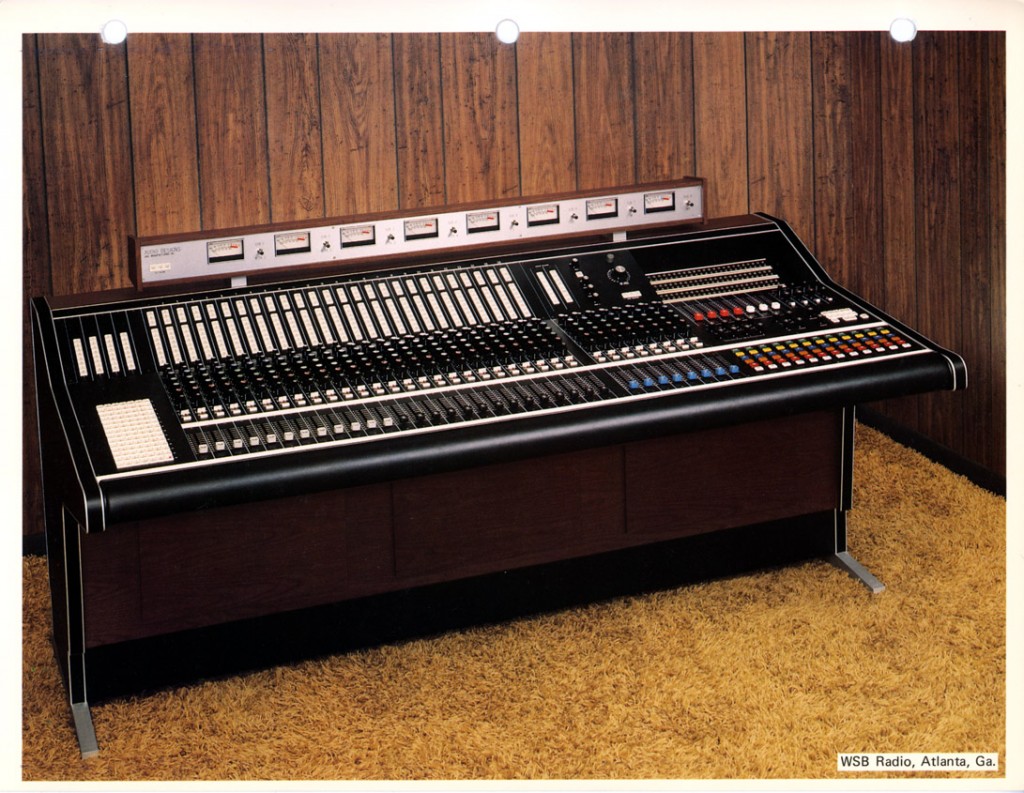 ADM Console constructed for WSB Radio, Atlanta
ADM Console constructed for WSB Radio, Atlanta
*************
*******
CIRCA 1980
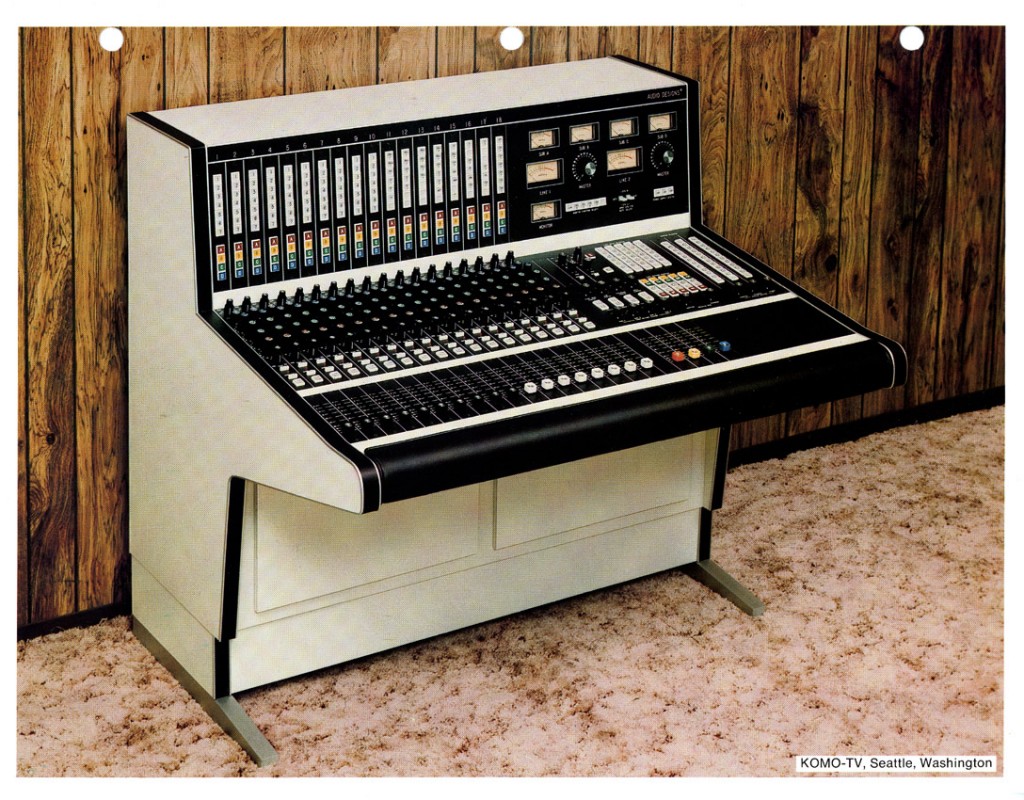 ADM console constructed for KOMO TV, Seattle
ADM console constructed for KOMO TV, Seattle
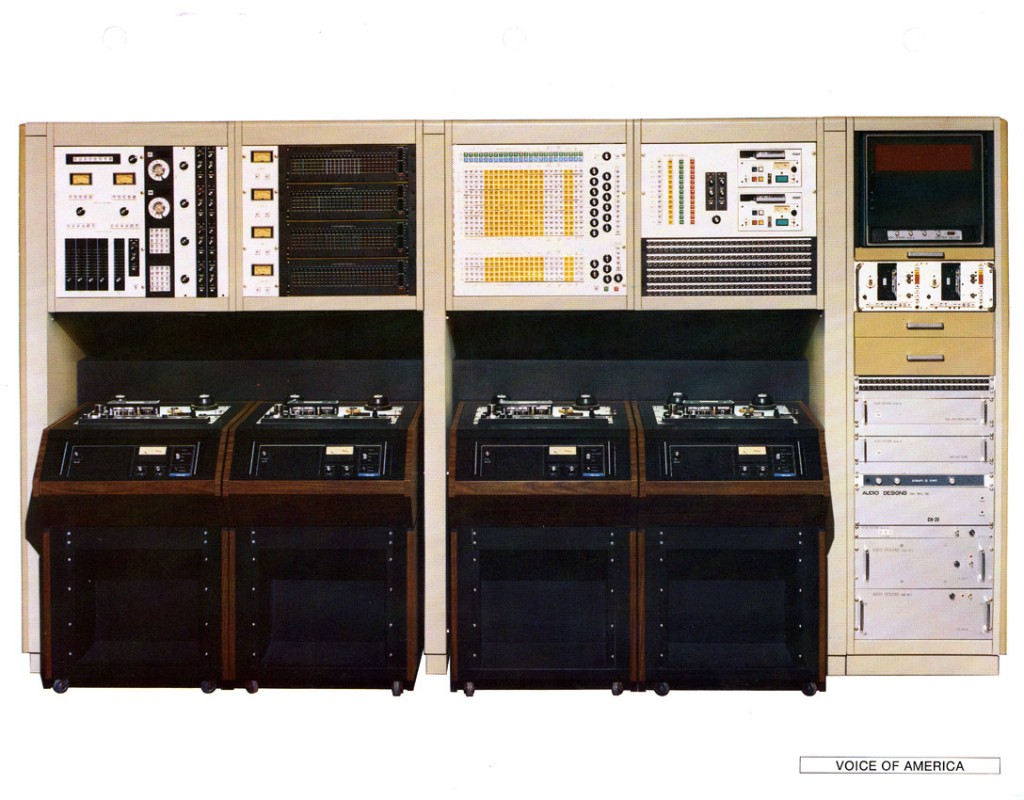 ADM Automation system constructed for the Voice Of America
ADM Automation system constructed for the Voice Of America
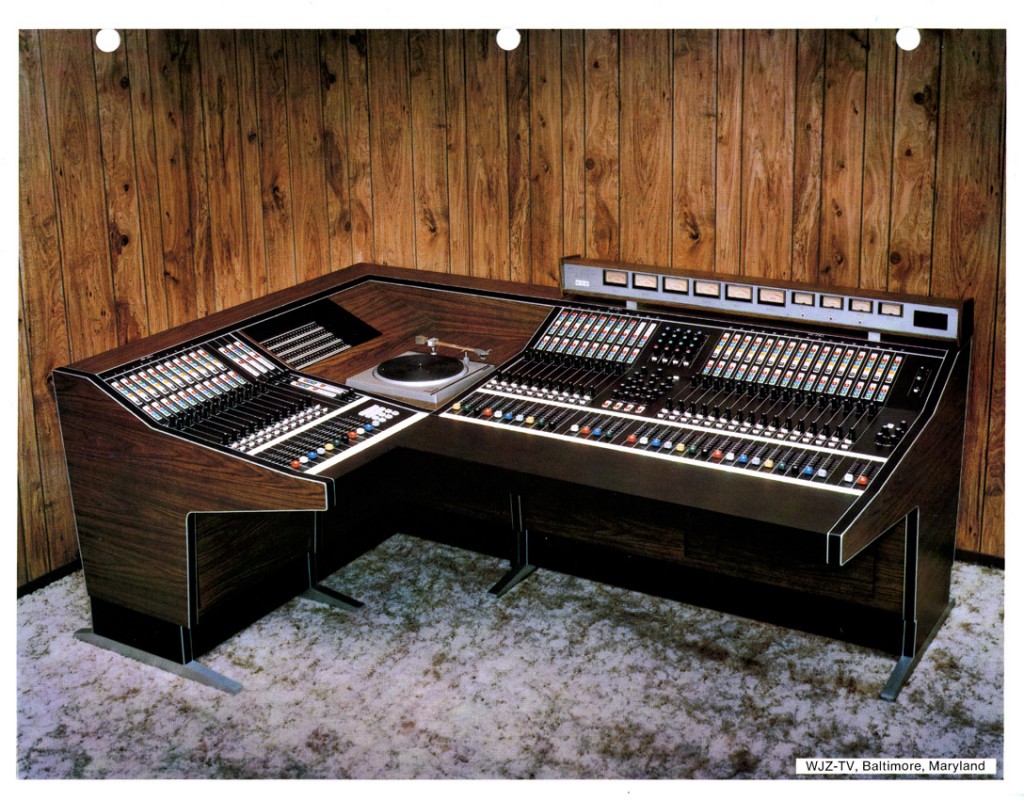 ADM Console constructed for WJZ TV, Baltimore
ADM Console constructed for WJZ TV, Baltimore
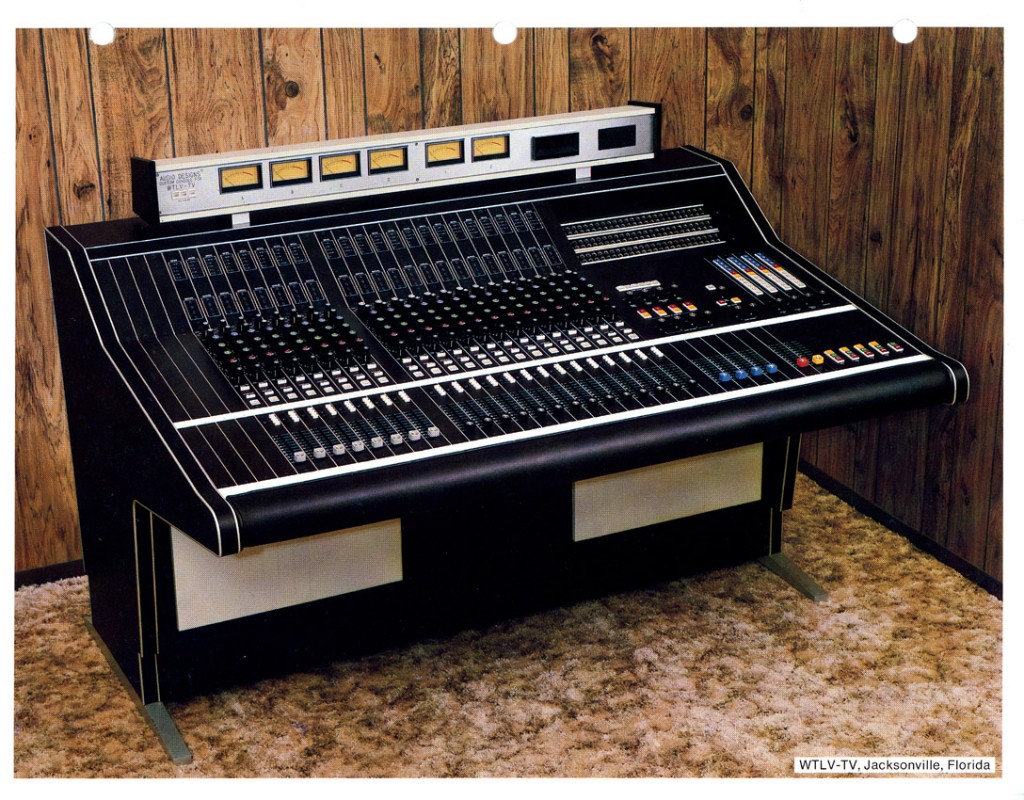 ADM console constructed for WTLV-TV, Jacksonville
ADM console constructed for WTLV-TV, Jacksonville
*************
*********
CIRCA MID 1980s
A later routing system constructed for NBC
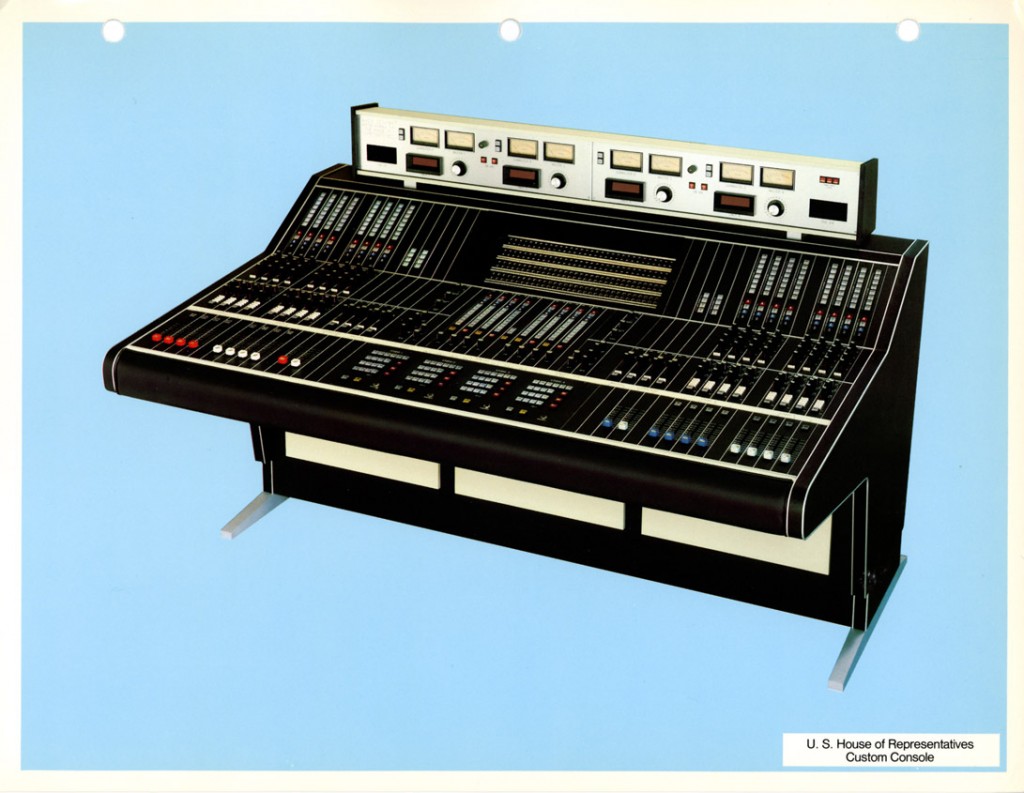 ADM console constructed for the U.S. House of Representatives
ADM console constructed for the U.S. House of Representatives
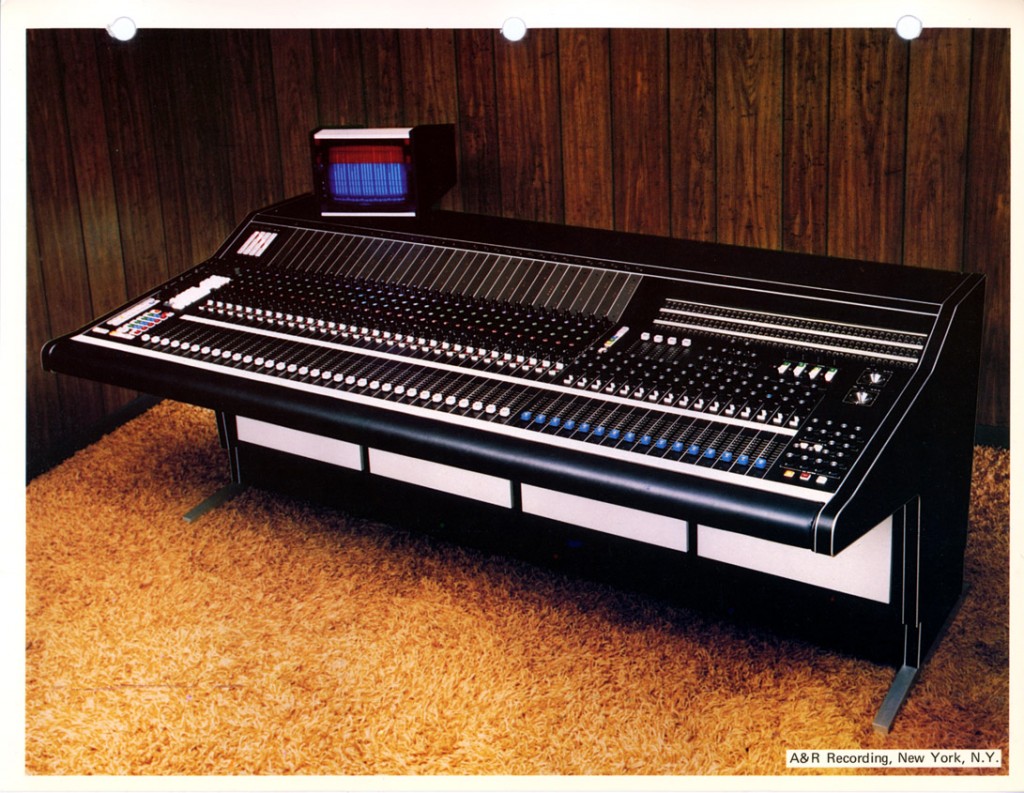
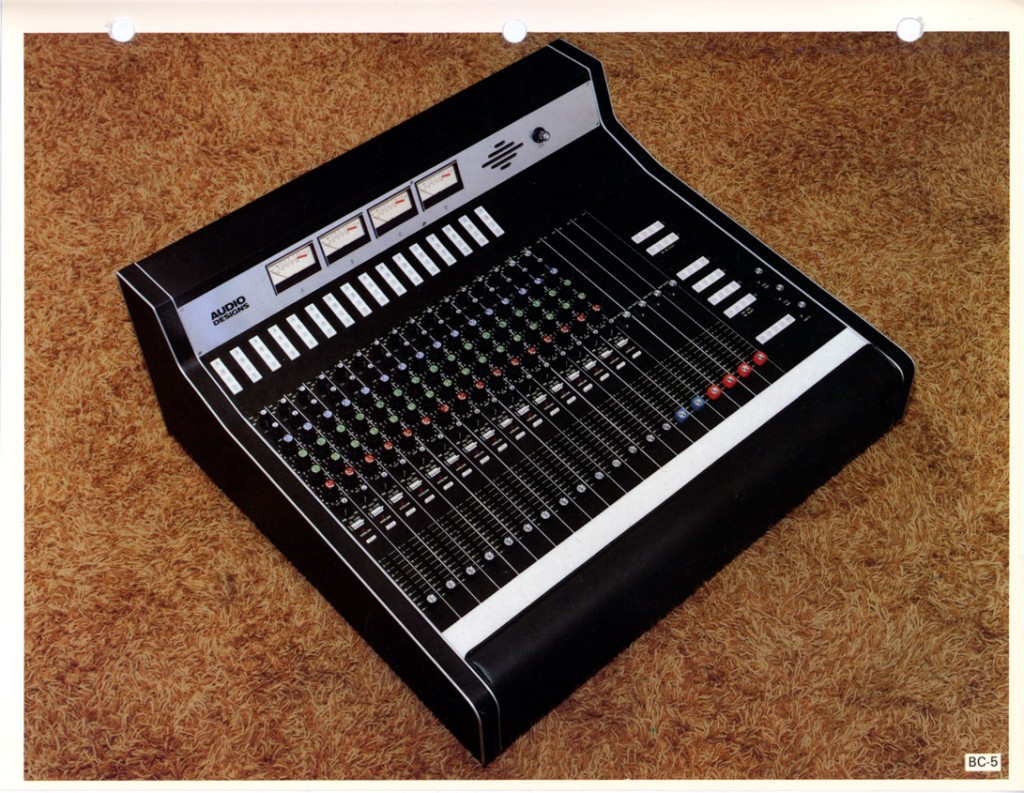
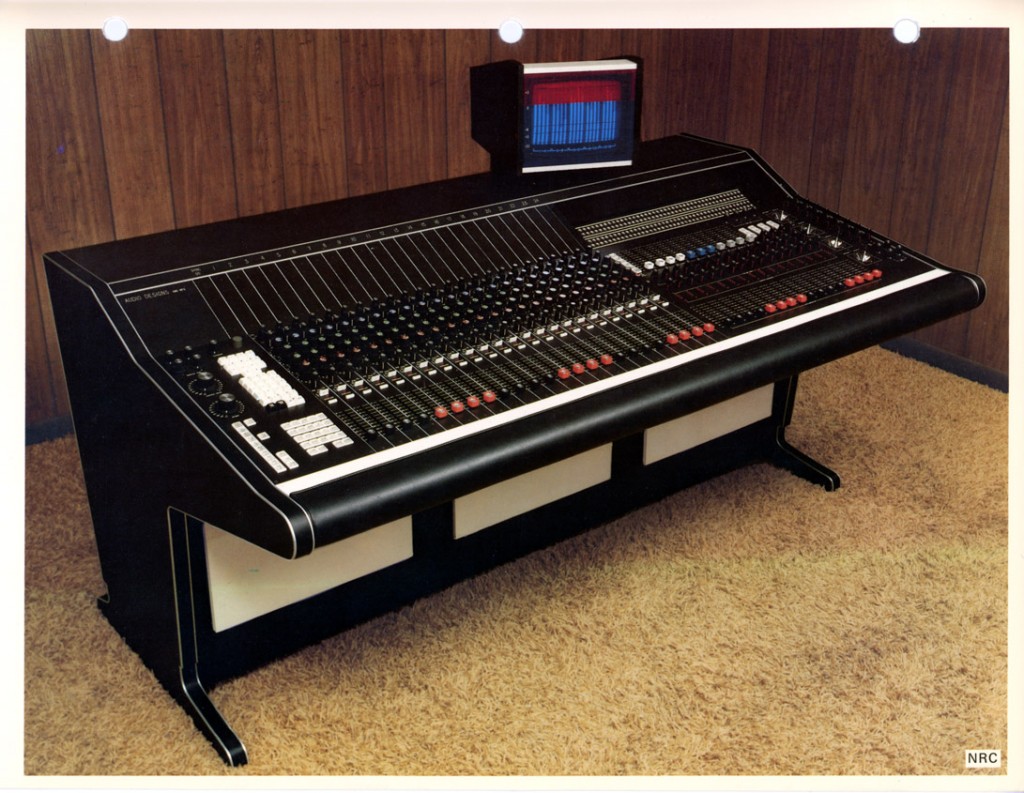
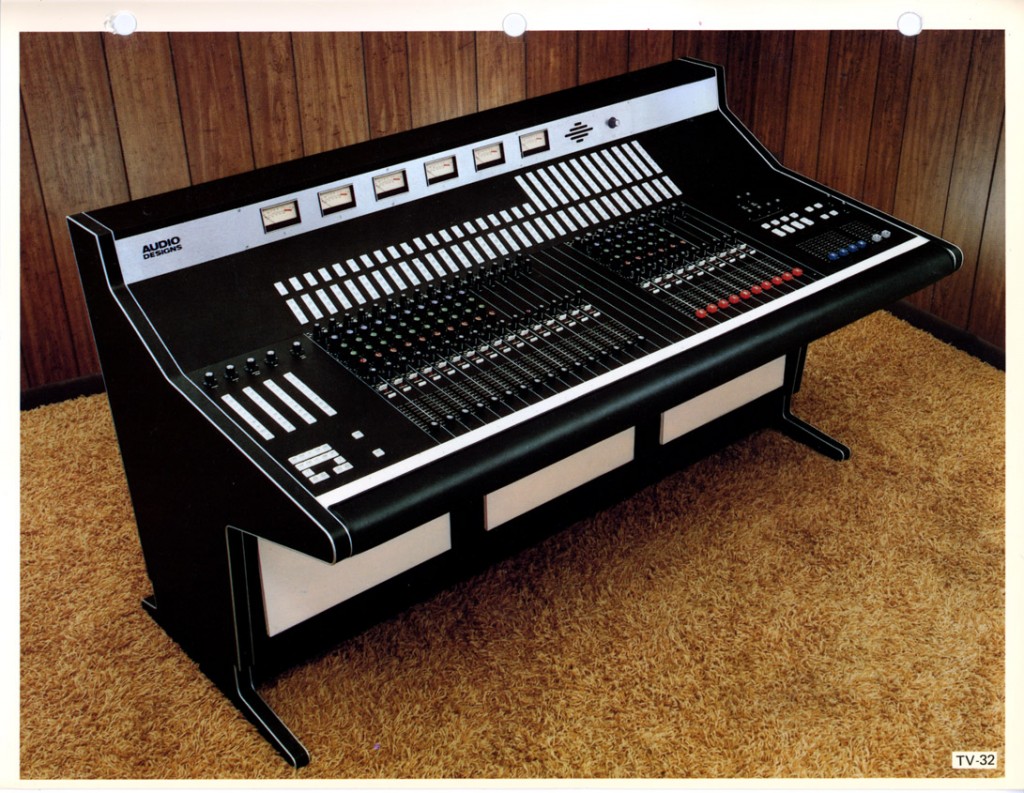
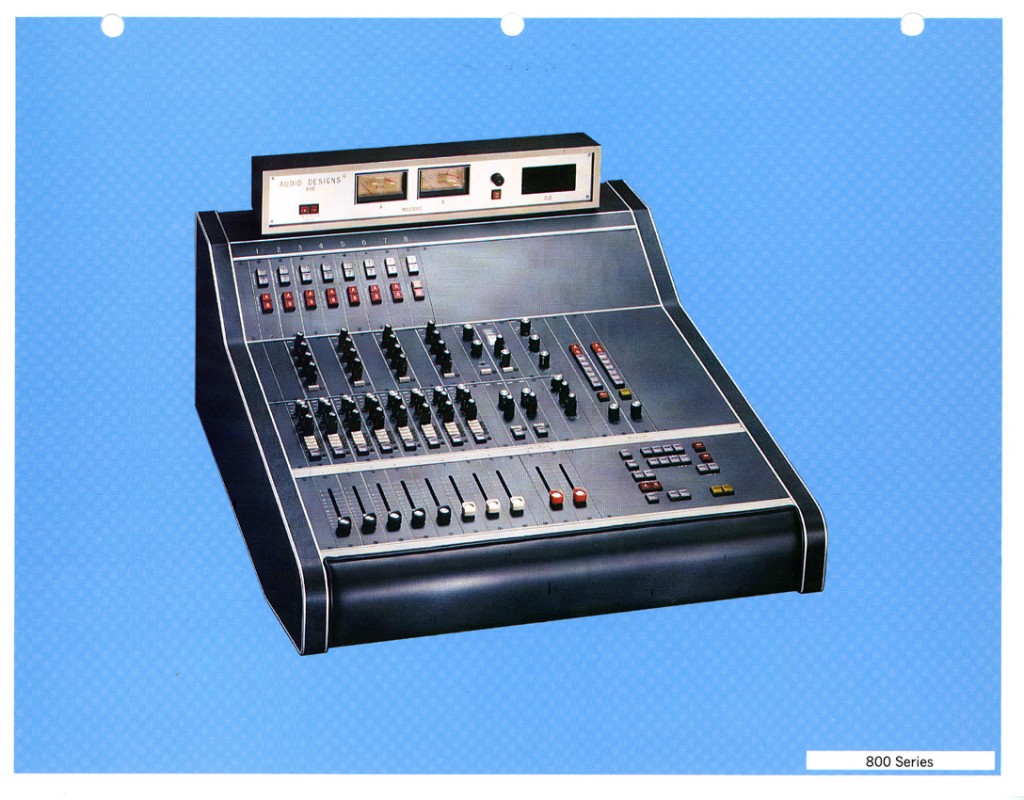
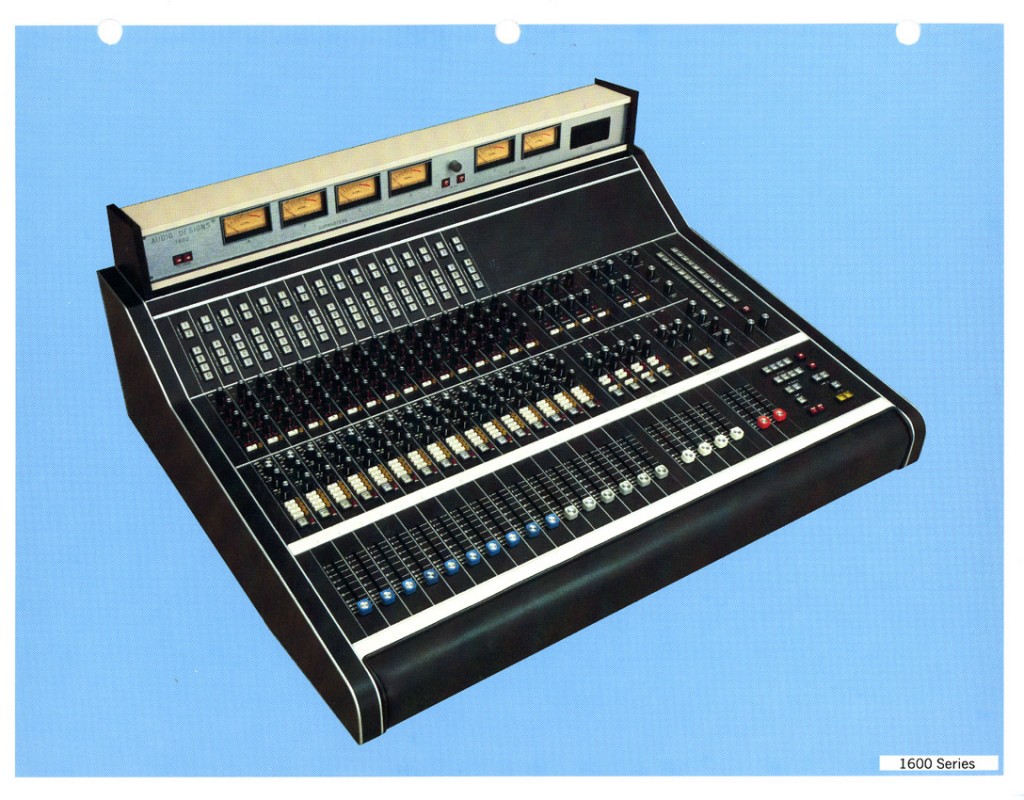
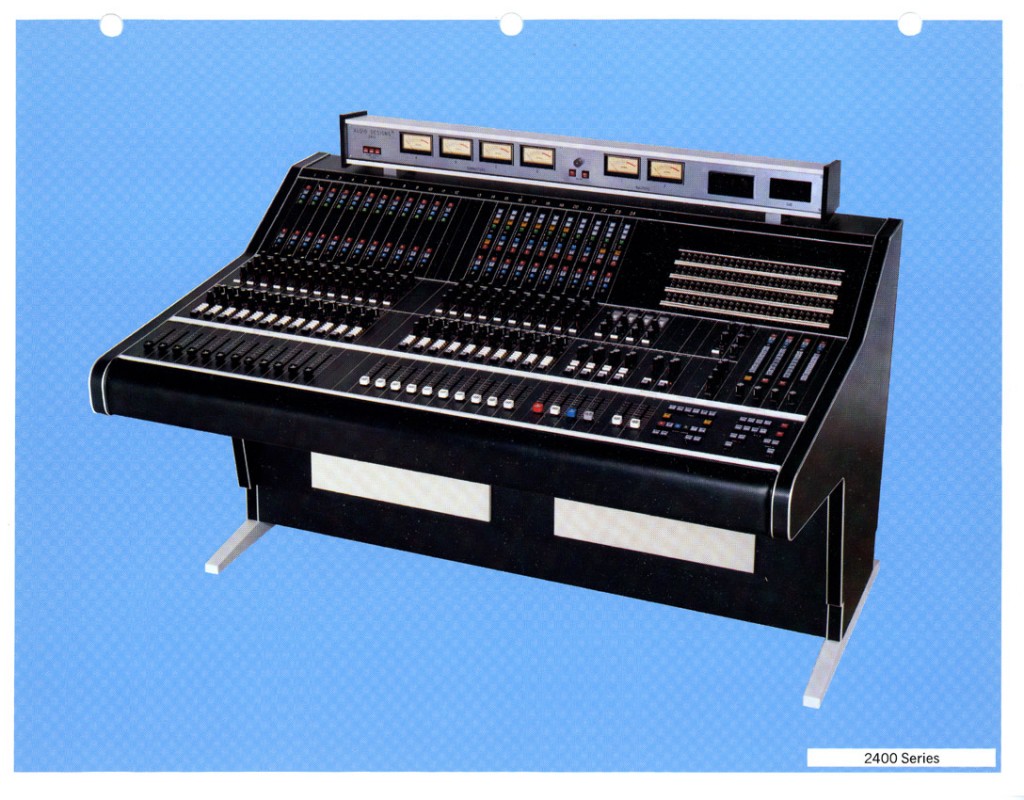
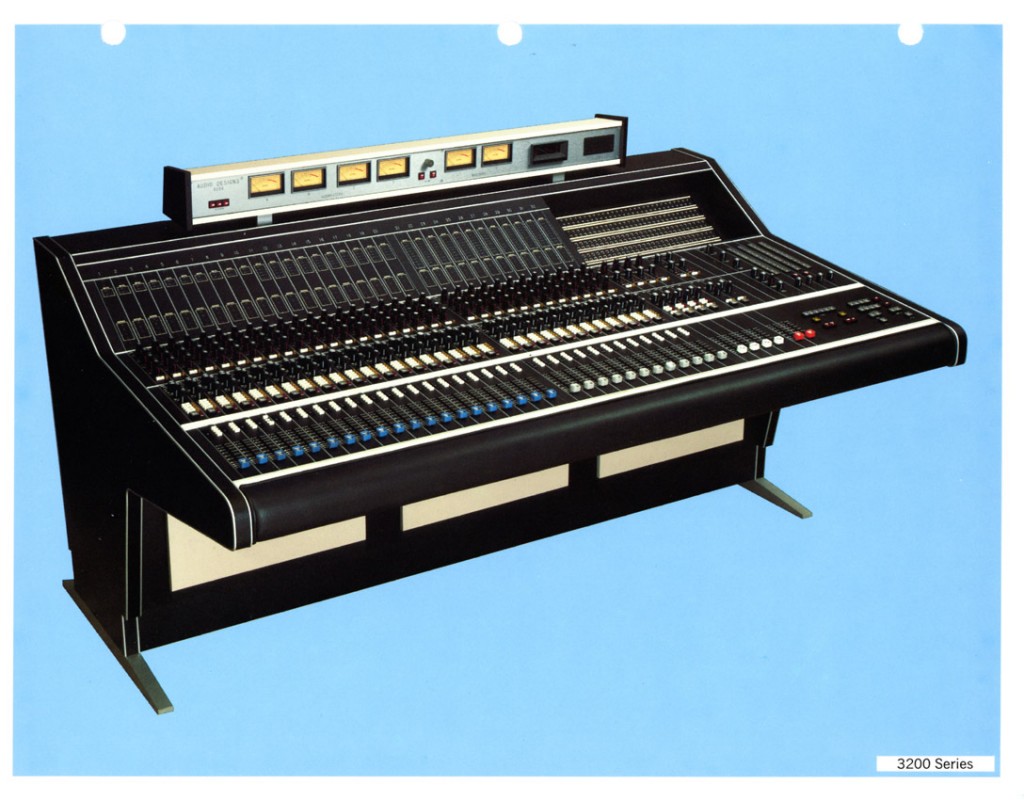
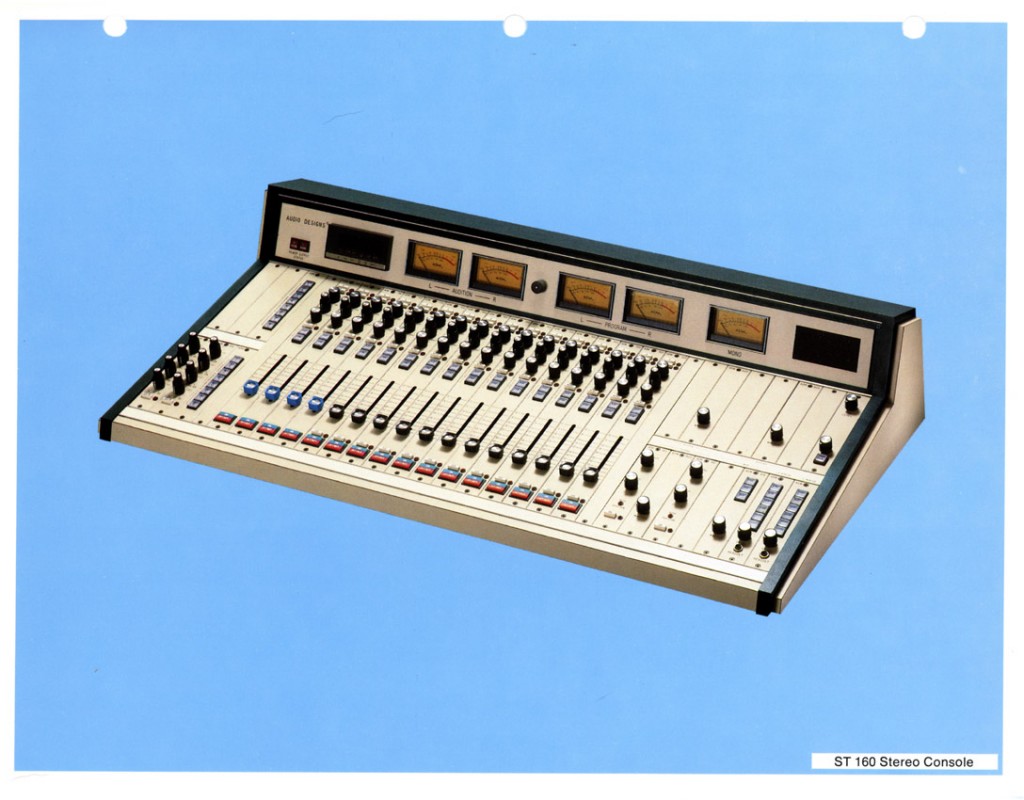
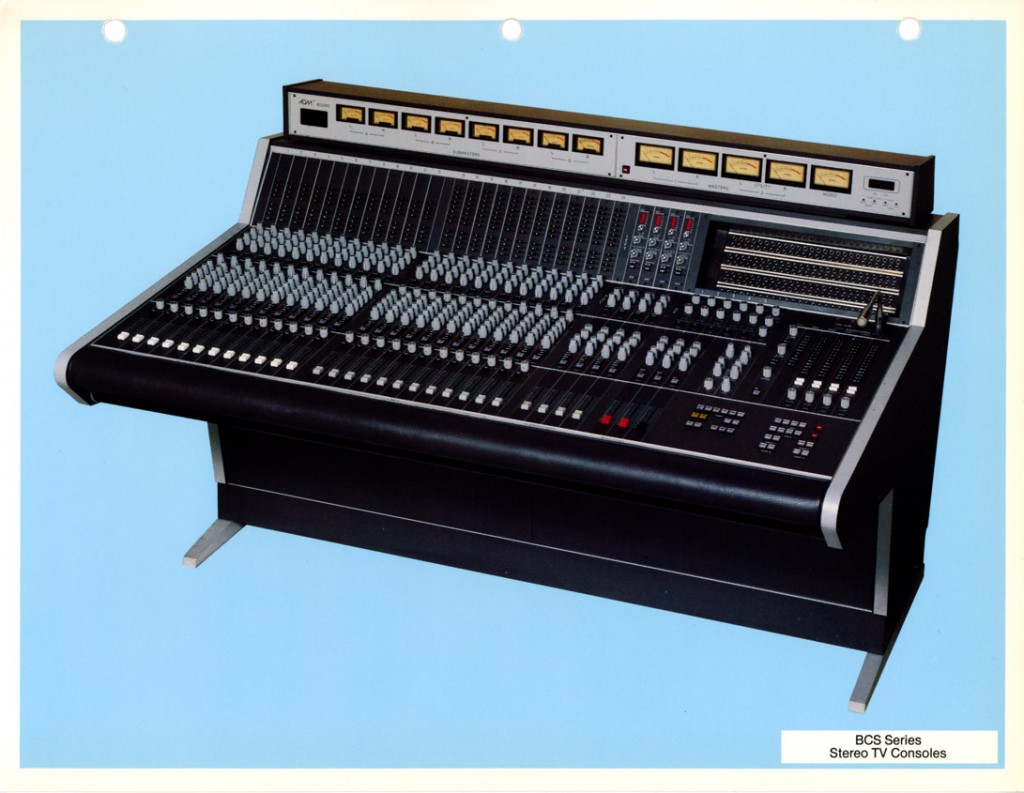
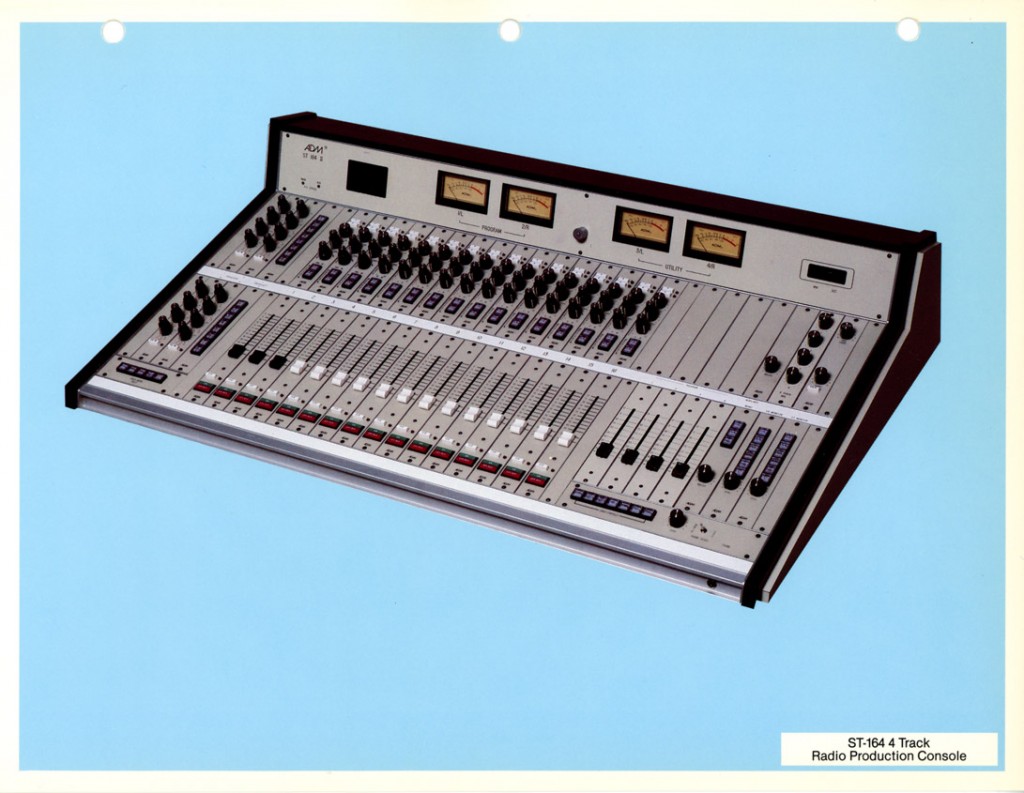
74 replies on “ADM Mixers and Consoles of the 1970s and 1980s”
Hi Chris:
ADM was owned by Bob Bloom. Bob started out in the 60’s making what were essentially solid-state channel strips (mic preamp, fader and maybe primitive EQ on a single circuit board) and he also made complete boards. Fine Recording was an early customer. When Studio B was converted to 8-track in 1967, Bloom made the one-off console. The tape machine was probably an Ampex AG-440-8, but the studio was later converted (briefly) to Scully’s short-lived 12-track format. Studio B was also the place for which JBL developed the monitor speaker that became their best-selling L-100 (see previous Preservation Sound posting for details and links).
Good shots of a Scully 12-track here:
http://www.sonicraft.com/Analog_To_Digital_Transfer_Gear.html#2
(I can’t say enough about the quality of Steve Puntollilo’s restorations and his studio).
Anyway, ADM also made the board for the conversion of Fine Recording Studio A (Ballroom) to 16-track in 1969:
https://www.preservationsound.com/wp-content/uploads/2012/02/ADM-Fine_Recording_Console_sm.jpg
ADM did most of their 70’s and 80’s business in the broadcast field, so that’s why bits and pieces show up on eBay all the time, a lot of boards were sold. They also did some business in Hollywood and overseas.
Their early-era channel-assign automation, which used a stepper-relay system similar to telephony, was patented. Also their Slidex curly-q mechanical/electrical fader. They had other patents.
ADM mic preamps from the mid-70s onward feature their own discrete op-amp as the first gain stage. Their EQ modules have an American sound, precise and with good headroom. They used UTC ouncer transformers in their boards, with well-designed and quiet padding available to prevent overloads. The general build on the boards was tank-like, which is why so many modules and other parts survived decades of daily abuse in the broadcast field only to be re-sold on eBay.
ADM’s corporate name was Audio Designs and Manufacturing Inc. at first and ADM Technology, Inc. in its later years. It was based in Michigan from at least the late 60’s onward, maybe all along.
Ironically, if ADM were still around, I bet they’d be an active player in what API and Rupert Neve Designs and others play in now — medium-format boards with analog front ends and digital integration with a DAW. I think you get a great combo in that MO — high-quality analog mic preamps and EQs plus the ability to mix channels and/or stems outside of the DAW and use the analog gear on the stems and master busses. Being old-school, of course I also favor NOT using anything resembling auto-tune, beat-alignment, etc (use that money to pay for music lessons and learn how to play together). Nice job with the ADM eye candy.
— Tom Fine
Hello again Tom/Chris:
I just found (in my archives from ADM) a (5″) reel tape in a A&R Recording box! Will dub it soon.
TomC
I’m not quite sure who I am addressing this to, however, I was just pointed to this web site by a co-worker and it certainly brings back memories. Didn’t know anyting like this existed. Chris, I don’t know who you are but would be interested in learning, the Photos shown were taken for the most part by a pro photographer in ADM’s conference room. Tom, some how I believe you are Bob Fine’s son. If so, it’s great to meet you he was my mentor, I knew him since I was a pre-teen.
Hi Bob. Welcome. You can learn more about me by clicking thru the ‘studio’ link at the top of the page; this will direct you to my commercial site. I am a recording engineer/television composer/educator/equipment builder, ex-(about a million other things). I’ll let Tom speak for himself…
Bob, AWESOME to see you here. I just stumbled on this site as someone was asking me about our early days in the mid-70s to early-80s and the console we had. I don’t know if you remember, but we purchased a 24x16x16 that you were showing at the NAB in Vegas around 1975. We drove a U-Haul from Fresno, CA to pick up the console after the show. I will tell you that this console sounded AMAZING until we finally moved to a Harrison in 1983. To be honest, the ADM sounded so much fatter than the Harrison. Wish I had pictures of those days….
Why is it so hard to believe a 5″ tape box from A&R?
Chuck Irwin
Hello Bob. I am a huge fan of your 1540 Eqs that I had years ago and wish I still Had. Literally everything sounded better through them, period…single tracks /instruments or mixes. My only wish was that sometimes I wanted a 1db increment instead of 2. I wish you would consider a new release of that EQ, maybe with a selectable 1-2 db??? I think you would sell many!! Or work with someone to release a faithful plugin, except I think I would always wish for the real hardware. Just thought… I miss your 1540’s and I’m looking for some more to replace the ones I shouldn’t have sold. Thanks!!! Rafe
Hey Rafe, I have many 1540’s.
Please contact me if your still interested in them.
Hi Bob,
Gary Rubin, from Pioneer Recording and had one of your first Boards at our Studio in Detroit. Actually helped you assemble and solder the circuit boards at your place on Wyoming across from Mumford High School for Special Recording and My own studio’s boards. Hope you are well.
I have racked up several sets of ADM preamp and EQ modules for clients, and have always been impressed with the quality.
I would LOVE to hear more from Bob Bloom regarding the history of ADM!
Best,
Brian
I knew Bob from the begining of ADM in Detroit. We were good friends back then, last saw him at an event at Wabeek Country Club. Also used to visit him at his larger facilities when he moved. He also loved to fly his own plane. I owned Pioneer Recording Studio in Detroit in the 60’s and 70’s. I know Bob had a serious accident while flying.
Really great to see Bob Bloom commenting here. I knew Bob briefly during a painful episode in ADM Technology’s history. I’ll save the story for my memoir. But, thanks for posting these pictures!
Hope this is within PS etiquette guidelines 😉
I bought a couple of ADM modules off of ebay and unfortunately the guy never got me the schematics for them – so if any one might be able to offer a suggestion on finding them, much much appreciated!
I will add that they seem really well-built and made for abusive situations. Wish I had more of their stuff, especially pre-amps or eq modules!
Here are the ones I have:
Fader: (black face plate) Slidex Linear Attenuator. A484-“x”-1. P/N: 3-010-3668. Has panning card (“pan in” button and pan pot), says “ADM Pan 1”.
Buss Selector: (black face plate) BSA 40x Series Buss Selector / Preselector (8 in, 4 out)
Chris, if this post isn’t cool for you, no worries – delete! I am just pretty much out of options on finding schemos for this stuff and your readers are certainly some real pros, so thought i’d try…
Cheers,
Steve
hey steve. nah this is exactly what these comments are for… I hope someone here can help ya out… Have you tried this dude on eBay: cqdx4u
I’ve bought schems from him before, he charged a fee but it was well reasonable.
good luck. c/
Oh yeah – I’ve seen his stuff – hard to miss that TG12345 he’s got for sale when you’re trolling for analog mixers! I will drop him a line about the schemos.
Thanks Chris!
Back in the 70’s, I was doing shows at the University of Houston at Clear Lake theater.
They had a ADM four channel quad with a main over head and stage monitor channel.
I did some “creative” shows with it.
In the early 80’s, I went to a NAB convention in Dallas. AMD had a display board set up. They were serving coffee and soft drinks. The rep would start talking about the mixer and the, , , pour his drink in the fader. Of course with the way the faders were designed, there was no damage. It was a very impressive demo.
Great mixers, just very expensive.
That’s the Slidex patented faders. The fader was a mechanical device, operating an assembly that turned a pot mounted away from the spillage zone. The pot controlled a VCA, which controlled the actual attenuation for the channel. Another ADM patented thing was their early channel-assign automation, which was based on the concept of stepped relays used in the telephone dialing system.
Back in the 70s, all high-quality professional consoles cost $$$$$.
— Tom Fine
Thanks for the info, Gents! Glad to have even a small part of history with these units.
I checked with cqdx4u but he said he’s not sure he had the schematics for these.
I am wondering if there are “similar” modules with more readily available schemos that i could gleen some details from…
Even just the Panning card has over 16 connection pins…doubt i can reverse engineer these guys!
Hey Steve,
Not sure if you are still looking….
I have a whole bunch of schematics from a 1979 broadcast ADM console.
Which modules do you need?
Looking for schematics for ADM 780 pre & 1540 EQ (615) 243 8442
Dear Mike,
i was searching schematic for input modules of mixing console ADM RFE/RL and i just find you here. I would be very glad and thankfull, if you could help me to get schematic or any information about this modules.
Thank you very much.
Best regards,
Ivo
Glad to see this preserved here. It was certainly a most exciting time in Analog Audio history.
I was a Design Engineer at Audio Designs / ADM from 1977 through 1983 (with a minor sabbatical!), working on the designs of many of these systems pictured here.
I worked through the original 770 era designs through the later 780/1540/320 designs and the digitally (6502) controlled analog consoles for Glen Glenn / Todd-AO Hollywood.
Thomas Chrapkiewicz
Detroit, Michigan, USA
Hi Thomas. thanks for getting in touch. if you have any cool factory photos, schematics, etc., that you can add to the pile here, LMK!
Could really use schematic for the 780 ADM pre much thanks, (615) 243 8442
What transformers did the 780 use on the input?
Boy does this bring back memories. I worked at Audio Designs from about 1974 through 1976. I started out being the ‘go-fer’ and ended up doing the console wiring checkout, running the wave solder machine, building some test fixtures and prototype circuits, etc, etc.
I had my hands on all of the consoles in the conference room pictures.
I worked for the salesman during that period. My cousin was an executive secretary Sharon. I made all the sales drawings that were do good you could print off the sepia and have no blue background.
I have an ADM st 160 which I still currently use for some analog projects. I really like the design and operation. The console I have was, as far as I can determine, from the studios at KJR Radio in Seattle. It was given to me along with 2 sets of spotcaster cart players and recorders, with about 30 used carts. I’ve since set it up to work with my reel to reels so that when I activate a channel it engages the drive. The r-r’s are in a rack away from the console and that seemed easier than stretching to hit the buttons. Even though the carts are mono they occasionally come in handy for dubbing in sound fx on stuff I’m working on.
I just saw this. How cool!
I was a test tech for ADM in 1979. My recollection included testing custom consoles and large switching/routing racks. I moved from Detroit area to the Hollywood recording studios and then to the film biz at Todd-AO Glen Glenn where those digitally (6502) controlled analog consoles Tom C spoke of resided. These were the film dubbing “pink” consoles. A few more standard 3200 ADM broadcast consoles were also in use there for television post sound mixing.
Fast forward to now…. Sadly, as of a few months ago, all of the Todd-AO facilities in the LA area have ceased operation. I work for the Academy of Motion Picture Arts and Sciences. We are building our new Academy Museum of Motion Pictures.
Some of the Todd Equipment and projection equipment will be repurposed there.
I’ve seen parts of those Todd Consoles for sale on eBay for years now.
Oh and…..by today’s standards the ADMs were extremely well built and VERY good-sounding! 🙂
Hi Tom, I hope all is well !
Take care all,
Jay Palmer
AMPAS Engineering
Hollywood, CA
Good to see this site; I’ve been gathering information too and hope to document further. There are two linked-in groups for any other alumni out there.
I worked in engineering at Audio Designs and ADM from 1977 through 1984 (with a brief sabbatical to work at Harris on a digitally controlled analog console (in 1979!).
Very few of the ADM consoles had VCAs in the main paths. I had worked on/designed the early dbx202 and dbx2001 designs for special projects. The latter was used in the Glen Glenn input strips. The GG boards were shipped out of Roseville; just before we moved to Troy. The company was there until 1989.
I also had the great fun to install/field test the VOA switching system.
All for now,
TomC
Wow, what a trip down memory lane. I worked at ADM from ’69-’85 with a couple of year long breaks. I started as the gopher much like Paul Z., moved into drafting doing detail drawings for many of the cabinets pictured and the schematics/wiring diagrams for many of them, by the time I left was doing PCB design. Had the pleasure of working with a BUNCH of good people over those years. I have to admit I have not enjoyed a job as much since.
What a trip down memory lane. I worked for Mr. Bloom from ’69 to ’85 with 2 one year breaks. Like Paul Z I started as the gopher then moved into drafting doing detail drawings for the console cabinets and the schematics and wiring diagrams for them as well as the modules. By the time I left I was doing PCB design. Worked with many good people there including but not limited to Tom C., Bill W.,Larry M., Larry B., etc. I must admit I haven’t enjoyed a job as much since.
Hey Brian I remember you. I wasn’t there for long but remember how hard you worked and the compliments you got. Do you remember old shakeys name or when he brought coffee back from Columbia.
Hello Brian. I would love to know any ifo you might be able to give me about the 1500 Eq’s…what era…and the difference between those and the 1540’s. I had and regrettably sold 4 1500’s that I loved…but I recently found and bought 4 1540’s. Thanks!!! Rafe Van Hoy rafevanhoy@yahoo.com
Does metro audio out of Detroit ring a bell anyone? I just acquired the metro audio remote truck, and it is outfitted with a very unique ADM console. I’ll send some pictures of it when I get the rig back to Detroit .
Paul:
Would love to see/hear more details!
TomC
Rings a big bell. I was a recording engineer and studio manager at Pampa Recording with Jim Bruzzese, and helped put the truck together. Chuck Buchanan owned it and the truck I believe was a J L Hudson delivery truck (a Grumman chassis?)
The ADM modules were from our studio was we were upgrading the console. The trucks claim to fame was recording Bob Seger and the Silver Bullet Band Live at Cobo Arena in 1975.
Would love to see the truck when you get it in Detroit shoot me an email!
By the way Bob and his crew at ADM were great, always ready to help and kept us running.
Greg
Hi Greg , excellent to hear from you. Getting the vehicle back to Detroit has been a long process. I went to Florida just to purchase the console in May, but got a bee in my bonnet, and decided to grab the whole rig. Many repairs to the vehicle , and months later, it’s almost ready to come home. As soon as it is, you will be the first to know.
The truck was also used to record the J. Geils Band ‘Full House’ album at the old Cinderella Theater in Detroit in the early ’70’s’. First hand knowledge as I was the stage manager there at that time.
Paul:
Did you ever publish any pictures?
Thanks,
TomC
Hello all.
I’m not very familiar with Adm mixers but I know they’re very high quality equipment. That being said if anyone is interested I have to Adm rack-mountable 20 volt 7.5A DC power supplies. They are in excellent to mint condition considering their age. Model numbers are PS2020-7.5 which is a dual power supply and a PS20-7.5 which is a single power supply. If interested contact me at my email address Brandontrybalski@gmail.com
Thanks
I ran the ADM console at KDKA in the late 80’s until it was replaced by an Auditronics. Outside of the filters failing one day in the power supply (we were back on the air in an hour and didn’t miss a broadcast) it kept running til the day it was dismantled.
Hey Don Bell. Email me if you could! I have some questions for you about the KDKA consoles. I just bought one.
My email is MarconeMusic at Gmail dot com
Here is a link to a photo of the KDKA TV console in 1989, the last year it was on the air.
https://www.flickr.com/photos/bisko7737/23674413860/in/dateposted/
It’s great to see all of this discussion about the ADM consoles. I recently acquired a 1600. Unfortunately, I have no docs for it, so if anyone has any, I would be eternally grateful. Mine will require some love, as it’s been sitting for a number of years. It’s beautifully made though, and I can’t wait to throw the switches!
Stephen, I have a dismantled 160 Mk II, some spare parts, and a full set of docs. Contact me radeng9805@msn.com.
I am very happy to see all this interest in the vintage ADM gear. I have a bunch of scanned documentation and would be happy to share if someone can provide public webspace. I need a couple of gigs. Not interested in a private transaction, but happy to upload to a publicly accessible space, or spaces.
I had a pile of ADM modules out of a big console that was at a TV station in Oklahoma, but never got around to doing anything with them. Sold them on eBay last year. I still have my 4-channel ADM universal amp rackup that Brian Roth made for me 10+ years ago. Still sounds great!
— Tom Fine
Hi, Tom. I know I’m responding to a post from a couple of years back, but did anything come of the idea of having some of your scanned documentation hosted somewhere? I’m currently building a small work room for myself, and I’m hoping my ADM 1600 will be the centerpiece. Thanks!
Stephen Egerton
Does anybody know where the two (2) ADM consoles at CI Recording ended up?
Thanks,
Chuck Irwin
Chuck:
Do you recall when they were purchased from ADM?
TomC
Wow I’ve done this trip before it always amazes me all the people associated with ADM how well they have done and what they did for the advancement of the state so long ago best to all
Tom C just told me of this site – I was not aware of it.
I,too, worked st ADM from 1976 to 1979 designing circuitry. It was my first professional job and I learned quite a bit while I was there. Its great to see the interest out there and read all the stories.
Nice to see you still checking back on this site. It is June 7, 2022, and just was scanning the Internet came across this site again. Hope you and the family are doing well.
Bob:
Thank YOU! You’ve been and were a great inspiration!
TomC
This is freckin cool. I have acquired the 3200 II from public broadcasting in Syracuse NY. I have learned a bit of great knowledge from this thread. Should this desk become my overdub room tracking console? This has been the question on my mind. I think it has been answered. I believe I have the manual and paperwork to go along with it. If I need some kind of assistance I’ll be back!!! CHEERS!
I worked part time at ADM from about 1972 to 1976 while attending Wayne State University. I did mechanical and electrical assembly of the recording consoles including some time in the machine shop. The Slidex slid rollers up and down a twisted metal flat that was mechanically coupled to a pot.
It was tricky to get them twisted correctly and adjusted so that no wobble was felt as the actuator was moved. I recall cleaning circuit boards from the wave soldering machine by swishing them around in a pan of Freon using bare hands. I hung around the test area during breaks and lunch, discussing making stero amps etc with the electronics guys. My first exposure to electronics had been making the Tiger stereo amp from a Popular Electronics magazine I had garbage picked from a neighbor.
I got a degree in Chemistry from Wayne State and was thrilled to discover there was plenty of electronics in science. Went on to Purdue for grad school as they have an Instrumentation group. Ended up being able to understand and blend the science of what people were trying to measure as well as the approaches if doing so. Spent 25 years at Univ. Michigan in their Electronics group in Chemistry having the freedom to tinker.
So thanks to Jerry Johnson at ADM for being willing to have me come back when school was out of session.
Steve
UTC O-8
Its been a known yet hardly ever talked about fact amongst us recording studio guys is that most broadcast consoles and their assoc gear were built ‘like tanks’ and had very excellent specs because the Broadcast engineers demanded in design to not add any noise etc into the path. Because there was already enough in transmission over the airwaves. The signal quality needed to be very high. The Routing and Buss options may not be as numerous as a Studio designed console and there arent Multitrack tape in’s needed for that environment But we respect the specs for sure. I’ve seen many a studio with Neve, etc broadcast consoles ‘converted’ for their needs.
Sturoc:
Thank you !!! – It’s curious you mention the quality of the broadcast consoles ‘back in the day’. At the time (I was at ADM for most of 1977 through 1983) I did not fully appreciate the quality of the parts we were designing with. I’ve recently studied the schematics of other ‘pro audio’ stuff of ‘those days’, and we were using the finest! My deep compliments to the circuit designers that preceded me at ADM and Audio Designs!!!
Thomas Chrapkiewicz
Detroit/Palo Alto
20190320
Very emotional reading all of this. I grew up at Audio Designs. Was privelidged to work with the finest, smartest people I have ever met. I was given opportunities to learn and travel the world. The lessons learned there caried me to retirement.
Thank you Bob Bloom.
Just to add this to the mix.. Here’s a link to a bunch of ADM specs, pics, and schematics that I refer to http://www.steampoweredradio.com/pdf/adm/adm%201982.pdf
[…] optimized for high-impedance mics like mine. Also, we both based our transformer designs on the ADM 780 console, so there’s an overlap there as […]
Having spent my formative years at ADM (1978 – 1984) I can truly say how much fun it was to work with the people there. Thanks to Bob Bloom for the opportunity. These pictures bring back great memories.
I worked on ADM consoles at Fine, and Mercury Sound Studios.
We also had two of them at C.I Recording. They were extremely reliable
great sounding consoles.
I wish I could just locate where ours went in later years.
Wow. Wonderful gathering here. I have a panel of illuminated ADM VU meters that looks like the simple aluminum front one way above for TEICHIKU TOKYO but is 8 across 3-high. Some are backed with fully stuffed PCB’s some with minimally loaded PCB’s. Anyone have a clue what would I need to get these going?
Did anyone ever reply with information about the (2) consoles at C.I Recording.
Very cool. Stumbled into this on my way to somewhere else…. I was a bench tech at ADM in Roseville 1976/1977, following 2 years at R.E.T.S (if anyone remembers that). Great memories, great place to work, great people. Nice beginning to my career. Worked at Michigan Bell for a while and was surprised they had a console in their broadcast department. Some of the names above are familiar, mostly Dennis Bennett who was my mentor. Thanks all for this trip.
The facility I built in 1976 purchased an ADM NRC 24×16 with the ‘TV’ meter display. An AMAZING sounding console, especially paired up with our Ampex MM-1100. I’m still amazed listening to some of those mixes 45-years later! Our ADM worked flawlessly until 1983 when it was replaced with a Harrison console and Studer decks.
Hello Eric:
Please drop me a note.
Thank you,
TomC
Hi.
I’m looking at a pair of 1500’s I’d like to buy. Does anyone have schematics or connector pin outs for the adm 1500..
Thanks very much.
Andy
Hello again, fellow ADM enthusiasts.
I’m fortunate to be coming into possession of an ADM ST100 (not the series II version), which is loaded with three 715 modules, seven 725 modules, two 1545 EQ’s, and two 320 compressors. I haven’t been able to find any info on these input modules. Is anyone here familiar with these, or have schematics for them?
I have schematics for the 1540 EQ, and the 1320 compressor, which I’m hoping will help make sense of them, but on the whole, this console is a very different beast from the 1600 I already have.
Any help would be much appreciated! Best to you all.
Stephen
Great to see the site is still attracting attention. I was around at the beginning of ADM. And Owned and operated Pioneer Recording Studio, on James Couzens Hwy.
Gary Rubin: Please drop me a note: tchrapkiewicz@gmail.com
I know this an old thread, but @Bob Bloom, if you see this, I believe you and your wife were friends with my folks, Rose and Stan Sigman. My dad was sort of peripherally involved with the AMJALAK amp project which you’re probably familiar with (Alan Miller was the brains behind it). I was really young, but I have memories of my dad and Burt Bacher forever bringing new iterations of the AMJALAK setup to our house to “test” them. I don’t know what ever happened to my dad’s AMJALAK setup; he had it for decades. (I still own the Pioneer turntable they had back then though.)